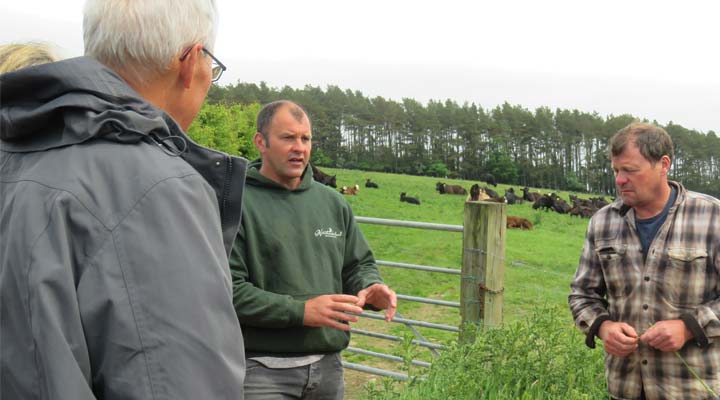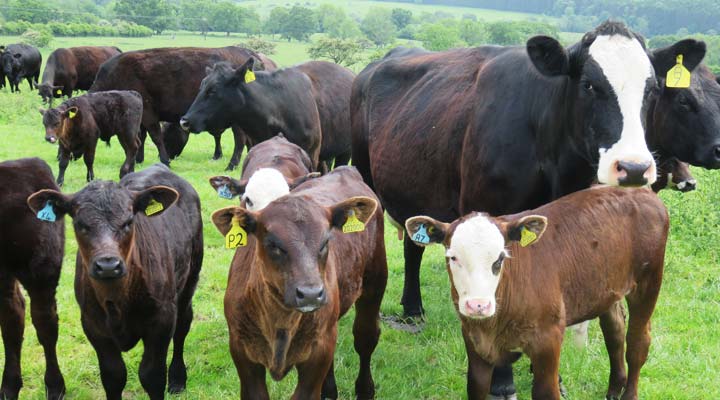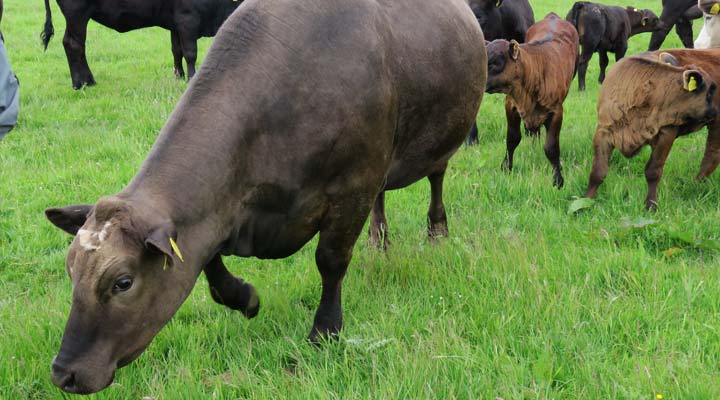Deep and open discussion benefits all on study tour

In 2000, the Nelless family farming near Morpeth in Northumberland set a new goal to farm in an enjoyable and rewarding way, without relying on subsidies to make a profit. Amongst other things, a focus on strict grassland management and organic conversion has allowed them to do this. Although, now with an additional farm and four livestock enterprises to manage, including the production and marketing of organic free range duck, chicken and turkeys, one wonders whether brothers Angus and Duncan have time to relax and enjoy the rewards!
The 160 spring-calving suckler cows, which Angus looks after, and 1900 Lleyn ewes and 600 ewe lambs which Duncan is responsible for, are run on tight mating patterns, which see all animals fed only grass and forage. In the herd, 93% of the cows are pregnant in six to seven weeks, which means the progeny is all very even in size.

The farm’s cattle have been Pasture for Life certified since 2016.
The Angus and Welsh Black heifers are calved at two years of age and 90 cattle are sold each year, finished at 315kg (steers) and 280kg (heifers) deadweight to Dovecote Park, at around 18 to 21 months of age, with average returns of £1400 a beast.
Four hundred and eighty of the ewes lamb from 22 March and the rest from 15 April. Duncan aims to finish all lambs off their mothers. Those that don’t, finish off red clover leys from late September. All the male rams are kept entire and the ewes are sheared at the end of February.
Duncan is a member of the AHDB/Signet RamCompare project, which sets out to compare rams of different breeds in terms of the performance of their offspring. All sheep are recorded at birth for metrics such as litter size, maternal score and assists.
Tricky season
This year as been difficult to manage, with snow and a late cold spring and then coming very dry.
“We have had three soft winters on the bounce,” said Duncan. “This one came as a bit of a shocker and the grass was very slow to grow. We had to feed the ewes plenty of additional forage this year, but they are looking good now.”
Duncan aims to have his ewes sitting at Condition Score 3 all year round, lambing easily and producing good colostrum off just grass. The aim is for 70kg ewes to produce a 40kg lamb at weaning.
Pasture management is crucial to the beef and sheep systems working and Duncan measures the fields with a sward stick each week of the growing season. The figures are entered in the Farmax programme, which produce grass growth curves to compare growth between years. Last year the total growth was nearly 10t DM/ha, with most growth between April and October. Being organic, growth can be slow in the spring, but usually romps away in summer when the clover kicks in.
“We rotationally graze the animals through a six paddock system,”
Duncan explained.
“We are looking for the cattle to go in at 3,000kg DM/ha. If fields are growing at higher than this utilisation by the animals goes right down. This is when we take a field out of the rotation and cut it for silage.
“There is no doubt that most ruminant farmers could do better with their grass,” said Duncan. “It is a lot easier to improve productivity by improving grassland management, than by changing breed.”
Angus agreed and said,
“Our business has to follow the grass growth curve as this is the way to keep costs right down. For example we keep as little machinery as possible – it has been years since Duncan sat on a tractor! All silaging and slot seeding is done by contractors.”
The Nelless brothers have recently become a certified Pasture for Life farm butcher so they can start selling 100% grass-fed beef and lamb.
“It would make us very proud to see more of our livestock sold as Pasture for Life. As markets for Pasture for Life products develop and returns match what we are receiving now from Dovecote Park, we are hopeful this can become a reality.”
Peelham Farm just in Scotland
After an evening spent in Berwick on Tweed, having a fantastic meal at Italian restaurant Gasparro’s, including some Peelham Farm charcuterie and slow roasted shin of Pasture for Life beef, the tour made its way north to visit the Walton family at Peelham.
Unusually, Chris and Denise have built up a very successful and award winning butchery and meat business from the farm, concentrating their efforts on developing and delivering a wide range of fresh and cured meats. These include the organic beef, lamb, hogget, mutton and pork from the farm and suckled veal from bought-in dairy calves. Every part of the animals are sold, including the marrow bones which sell wholesale for £8.50 per 2kg pack.
They have paid particular attention to producing a wide range of cured meats, many air-dried in one of the old limestone-walled barns. There is a wide range of products including smoked Nduja, a spreadable salami, air-dried smoked juniper mutton and Droewors – a beef salami stick with coriander.

“We started taking our food to the consumer 15 years ago, when the farmers’ market movement was just getting going, and established a customer base in places like Edinburgh, Glasgow and Kelso,”
Denise explained.
“We built our own butchery and developed products inspired by the Slow Food/Terra Madre movement in Italy. Things were tough at times but we focused on the butchery and beyond, to make it grow. We now employ three butchers and one quality control person. Online sales are also increasing.
“Curing is a good way of adding value to an animal. For example, you can sell a cull ewe for £18 a head, or cure one of its legs and sell it sliced for £55/kg.”
Improving the farm
In 2015, son Angus came home after ten years away and took on the management of the 650-acre farm, which is owned in partnership with his parents and business partner Amanda Cayley.
The organic, mixed farm was employing four people, but had not been managed efficiently and lacked infrastructure. Since coming home, Angus has put in 32,000 metres of fencing.
“We now have three livestock enterprises: grass reared and fattened Aberdeen Angus X Luing cattle, Lleyn x Texel X Highlander sheep and free-range Tamworth X Red Duroc sows, which are all grazing the pastures,”
says Angus.
“Now that I have fenced most of the fields it will be easier to graze them effectively.”

Grazing decisions
On the walk around the farm, there was much discussion about how Angus could do this.
There were suggestions that some set stocked fields should be divided and split into smaller daily grazing sections for rotational/mob grazing and that the mobs could be combined. This would allow the pastures to replenish and rejuvenate and give the stock a regular supply of high quality feed.
Back at the farmhouse, these discussions continued, with PFLA members sharing their knowledge, doing calculations and learning together how to manage pasture for ease of management, the environment, the animal and the bottom line.
“This is the great thing about PFLA events,” said Russ Carrington, PFLA general manager, who led the tour.
“Everybody learns from each other and the collective knowledge really helps farm businesses to make significant steps forward.”
Comments made after the study tour by delegates
- I have been on a lot of farm tours and I can safely say that I gained more from these two days that I have from the rest combined
- I am inspired to analyse the costs in my business better and find out where the money is being lost and made
- I am now more confident to give rotational grazing a try and move away from set-stocking
- I have seen what can be done and will be visiting other Pasture for Life farmers so that I can refine my own system at home
- I now know what I need to do to reduce the finishing times of my animals
- I am so glad to have joined the PFLA network and will be reaching out to other members to learn more along my farming journey
- I am inspired to think deeper and wider about the farm business I am developing
- It is great to be part of a peer group which is young and open-minded



